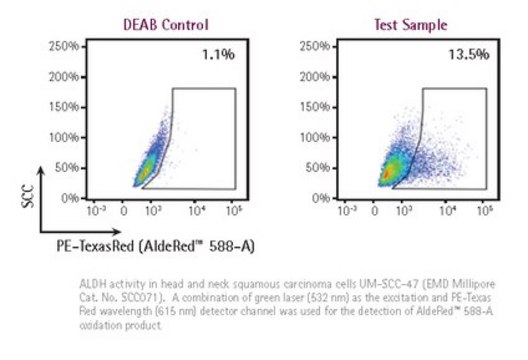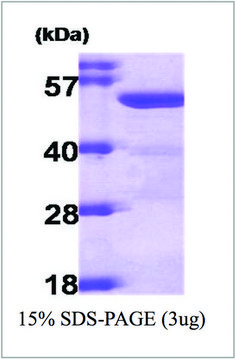MAK082
Aldehyde Dehydrogenase Activity Colorimetric Assay Kit
sufficient for 100 colorimetric tests
Sign Into View Organizational & Contract Pricing
All Photos(3)
Synonym(s):
ALDH Activity Assay Kit
UNSPSC Code:
12161503
NACRES:
NA.84
Recommended Products
usage
sufficient for 100 colorimetric tests
detection method
colorimetric
relevant disease(s)
cardiovascular diseases; cancer; hematological disorder
storage temp.
−20°C
Related Categories
General description
Aldehyde dehydrogenases (ALDH) are a family of enzymes that catalyze the metabolism of exogenous and endogenous aldehydes, preventing the accumulation of potentially reactive and toxic aldehydes and their metabolites. In addition to their role in aldehyde metabolism, ALDH enzymes also play critical roles in other cellular processes such as cell proliferation, differentiation, and survival. Mutations in ALDH family members have been linked to numerous diseases such as heart disease, cataracts, and certain cancers. ALDH activity may also serve as a marker for certain stem cell populations including hematopoietic stem cells and certain cancer stem cells.
Application
Aldehyde Dehydrogenase Activity Colorimetric Assay Kit has been used to measure the activity of aldehyde dehydrogenase.
Features and Benefits
Compatible with high-throughput handling systems.
Suitability
Suitable for the measurement of aldehyde dehydrogenase (ALDH) in a variety of samples including tissue and cells
Principle
The Aldehyde Dehydrogenase Activity Colorimetric Assay kit provides a simple and direct procedure for measuring NAD-dependent ALDH activity in a variety of samples. ALDH activity is determined by a coupled enzyme assay in which acetaldehyde is oxidized by ALDH generating NADH, which reacts with a probe generating a colorimetric (450 nm) product proportional to the ALDH activity present. One unit of ALDH is the amount of enzyme that will generate 1.0 μmole of NADH per minute at pH 8.0 at room temperature.
Signal Word
Danger
Hazard Statements
Precautionary Statements
Hazard Classifications
Carc. 1B - Eye Dam. 1 - Skin Corr. 1B
WGK
WGK 3
Regulatory Information
含少量动物源组分生物产品
常规特殊物品
Certificates of Analysis (COA)
Search for Certificates of Analysis (COA) by entering the products Lot/Batch Number. Lot and Batch Numbers can be found on a product’s label following the words ‘Lot’ or ‘Batch’.
Already Own This Product?
Find documentation for the products that you have recently purchased in the Document Library.
A Novel Long Non-Coding RNA lnc030 Maintains Breast Cancer Stem Cell Stemness by Stabilizing SQLE mRNA and Increasing Cholesterol Synthesis.
Yilu Qin et al.
Advanced science (Weinheim, Baden-Wurttemberg, Germany), 9(24), e2204046-e2204046 (2022-08-26)
Characterization of the CD49f+/CD44+/CD24- single-cell derived stem cell population in basal-like DCIS cells.
Duru N, et al.
Oncotarget, 7(30), 47511-47511 (2016)
Xiaotian Xu et al.
Aging, 14(11), 4858-4873 (2022-06-10)
The roles of asparagine-linked glycosylation (ALG) members in tumorigenic process have been widely explored. However, their effects in colorectal cancer progression are still confusing. Here, we screened 12 ALGs' expression through online datasets and found that ALG10 was mostly upregulated
Yilu Qin et al.
Advanced science (Weinheim, Baden-Wurttemberg, Germany), 8(2), 2002232-2002232 (2021-01-30)
Cancer stem cells (CSCs) are considered the roots of cancer metastasis and recurrence (CSCs), due in part to their self-renewal and therapy resistance properties. However, the underlying mechanisms for the regulation of CSC stemness are poorly understood. Recently, increasing evidence
Ting Liu et al.
Bioengineered, 12(1), 7143-7155 (2021-09-22)
Cancer stem cell (CSC) has been confirmed to trigger tumor occurrence and progression and CSC can develop strategies to maintain a lower reactive oxygen species (ROS) level compared to cancer cells. However, the mechanisms contributing to ROS homeostasis in CSC
Articles
AldeRed™ 588-A detects ALDH activity in cancer stem cells, aiding in cancer research.
Our team of scientists has experience in all areas of research including Life Science, Material Science, Chemical Synthesis, Chromatography, Analytical and many others.
Contact Technical Service




